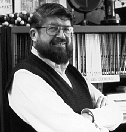
RICHARD E. DICKERSON
Professor; Director, the Molecular Biology Institute; PhD, Physical
Chemistry, University of Minnesota; Postdoctoral Scholar, Leeds and
Cambridge Universities, England.
Research Description :
DNA sequence is recognized by drug molecules, and by restriction enzymes, repressors and other control proteins that seek out specific target sites on
the double helix and bind to them. How is this reading of sequence
achieved? Why does a drug or a protein bind to one segment of DNA and
ignore others? Part of the recognition process involves hydrogen bonding
to the edges of base pairs down along the floor of the major and minor
grooves. But part also involves bending and twisting the DNA to fit the protein. This deformability of DNA is different from one base sequence
to another, and constitutes a part of the recognition process. Four main
x-ray crystal structure projects are under way in our group:
(1) Analysis of short DNA oligomers, to study sequence-structure relationships. We recently have discovered a sequence, T-G-G-C-C-A, that
causes a 23[[ring]] bend in the helix axis.
(2) Study of complexes of DNA with groove-binding antitumor drugs, and
design of drug analogues that will read DNA base target sequences of
our choosing. Examples: netropsin, Hoechst 33258, anthramycin.
(3) Structure analysis of control proteins that bind to specific
DNA sequences, including Fis, Hin, and TFIID/B.
(4) Kinetic assay of inhibition of the reverse transcriptase of the
AIDS virus, HIV, by groove-binding drug molecules.
When we learn the rules for recognition of DNA by control molecules, then
we can tailor the control to our own purposes.
Keywords & Concepts:
Biochemistry and Geophysics: X-ray analysis of DNA and of its complexes
with antitumor drugs and control proteins; molecular sequence and
molecular recognition in DNA; molecular evolution.
Last
Revision: 10/26/95 // mk
